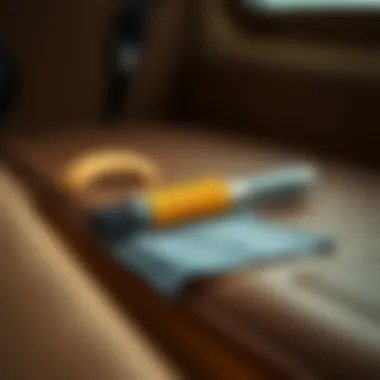Techniques to Remove Mildew Stains from Boat Seats


Intro
Maintaining a boat is no small task. It's a labor of love that requires diligence and a keen eye for detail. One of the more troublesome foes that boat owners often face is mildew, particularly on seats and upholstery. These stubborn stains not only mar the aesthetic appeal of your vessel, they can also affect the integrity of the materials involved. Understanding how mildew forms is the first step towards effectively combating it.
This article will explore practical techniques for removing old mildew stains from boat seats, equipping you with knowledge and skills for chemical use, scrubbing methods, and preventive measures. By the end of it, you should have a well-rounded toolkit to not just tackle existing mildew but also keep it at bay in the future.
Market Research Overview
Industry Trends and Insights
The marine industry has seen a steady rise in boat ownership, with many individuals opting for recreational boating as a means to escape the daily grind. In conjunction with this growth, the demand for cleaning and maintenance products tailored specifically for marine environments has increased as well. Specialty brands are now emerging that focus on sustainable cleaning solutions. This trend towards eco-friendly products is crucial; boat owners today are more conscious of their environmental impact than ever.
Given the unique challenges posed by marine conditions, effective cleaning agents must both eliminate stains and protect surfaces from harsh saltwater environments. Understanding what's currently popular in the market regarding cleaning agents can empower consumers and influence purchasing decisions.
Consumer Demographics
The typical consumer demographic for boat cleaning products tends to be varied, encompassing both seasoned boat owners and newcomers alike. Age-wise, the audience spans from young adults to retirees. However, individuals aged 30 to 55, typically owning varied types of boats, are more likely to seek in-depth information on upkeep. A common thread linking these groups is the health and longevity of their investment. Moreover, tech-savvy consumers in this demographic often turn to online platforms to find reviews, tutorials, and tips, encouraging a community-like environment where knowledge thrives.
"Understanding how mildew forms and how to combat it can save both time and resources for every boat owner."
Cleaning Techniques and Tools
Necessary Cleaning Supplies
Before embarking on the drying and scrubbing adventure, understanding what cleaning supplies will serve your needs best is essential. Here’s a brief list:
- Mildew Remover: Products specifically formulated for marine upholstery are preferable. Look for brands like 3M Marine Mildew Stain Remover or Star brite Mildew Stain Remover.
- Soft Brush: A gentle scrub brush that won't damage your material.
- White Vinegar: An excellent natural cleaner that also helps in odor removal.
- Spray Bottle: For easy application of the cleaning solution.
- Protective Gear: Gloves and masks can shield against potentially harmful chemicals.
Step-by-Step Process
- Preparation: Begin by removing any cushions or covers that can be detached. It’ll make the cleaning process smoother.
- Drying: If possible, let the seats dry in sunlight for a few hours. Sunlight has natural disinfectant properties that help reduce mildew spores.
- Apply Cleaner: Choose your preferred cleaning solution. If you opt for a store-bought cleaner, follow the instructions precisely. For a homemade solution, a ratio of one part water to one part vinegar can work wonders.
- Scrubbing: Using your soft brush, gently scrub the stained areas. Be cautious not to be overly vigorous, which may damage the fabric.
- Rinse and Dry: Rinse with clean water and allow the area to dry thoroughly. Not drying properly may invite mildew back in, making your efforts futile.
By following these practical steps, you’ll find that mildew stains can be addressed efficiently, ensuring your upholstery retains its charm for many outings to come.
Culmination
Understanding the causes of mildew and having solid techniques ready grants boat owners confidence. This knowledge not only preserves the beauty of your vessel but also contributes to a healthier environment aboard. The right cleaning supplies, methods, and regular maintenance can significantly enhance your boating experience. Stick with these insights and you'll sail smoother waters.
Understanding Mildew and Its Impact on Boat Seats
Mildew is more than just a cosmetic issue on boat seats; it poses significant threats to both the integrity and appearance of your vessel. This section aims to underscore the crucial understanding of mildew—the enemy that can wreak havoc if left unchecked.
Recognizing mildew's impact allows boat owners to take timely action, ensuring their seats remain safe and inviting. Mildew doesn't just sit pretty; it thrives in damp, warm environments, making boats a prime target, especially after prolonged exposure to the elements.
Knowing mildew means knowing prevention. By diving into this topic, we explore the dynamics of mildew formation and how to effectively remove it—saving boat owners time, money, and effort in the long run.
Defining Mildew: The Fungal Threat
Mildew is essentially a type of fungus—something akin to the unwelcome guest that shows up to a party uninvited. Characterized by its grayish-white appearance, it often lurks in areas that experience consistent moisture. It's not just a nuisance; it's a sign of potential underlying issues, including poor material treatment or inadequate cleaning routines. Essentially, mildew can strike fear into the heart of any boat owner.
Understanding mildew allows owners to take proactive measures. To put it plainly, ignoring mildew could lead your boat seats down the slippery slope of deterioration.
Common Causes of Mildew Growth on Boats
Mildew does not appear out of thin air; it requires specific conditions to thrive. By pinpointing these contributing factors, boat owners can act swiftly to mitigate risks. Here are the main culprits:
Moisture Accumulation
Moisture accumulation is like a welcome mat for mildew. When water seeps into the upholstery, whether from rain, spilled drinks, or humidity, it creates a breeding ground for fungi to flourish. Boat materials that retain moisture are particularly susceptible. For instance, if the seats aren't made from water-resistant material, you're asking for trouble.
Knowing how moisture interacts with your upholstery is essential. It emphasizes that prevention starts with keeping upholstery dry and free from spills, ensuring that your boat continues to look fresh.
Temperature Variations


Temperature variations play a stealthy role in mildew formation. As temperatures rise during the day, the materials can heat up, and then cool down at night. This cycle causes condensation, leading to moisture accumulation in the fibers of the seating. It’s a bit like leaving a soda can in a car during a hot day and then opening it as it cools—the moisture inside starts to collect.
Understanding these shifts helps in strategic planning. If you know that temperature fluctuations are common in your boating environment, then extra precautions can be implemented to limit mildew formation.
Lack of Ventilation
A lack of ventilation is akin to designing a closed-off room with no windows. In boats, this can happen if there's insufficient airflow, especially when the boat is not in use for extended periods. Stagnant air allows moisture to settle, creating a perfect breeding ground for mildew.
A well-ventilated space mitigates this risk tremendously and promotes drying out after exposure to moisture. It’s an easy fix—you just need to think like a sailor seeking the freshest breeze.
Consequences of Mildew on Boat Upholstery
Ignoring mildew can have dire consequences that extend beyond just appearances. Failing to address the issue can cause extensive harm to your boat, impacting various facets:
Structural Damage
Structural damage caused by mildew can sneak up on you. It begins as little spots on the upholstery but can escalate to deterioration of materials over time. Once the fibers break down, it's not just about aesthetics; you may need to replace elements of the seating. Think of this as the cracking paint on an old weathered boat—what starts as a small flaw can lead to serious issues down the road.
Being aware of this connection helps boat owners appreciate the urgency in tackling mildew early.
Aesthetic Concerns
Aesthetics matter, especially on a vessel designed to impress. Mildew stains can create a less-than-desirable look, taking away from the beauty of your craft. Imagine showing up at a marina with seat covers that look like they've seen better days. Not ideal, right? Also, a well-maintained boat speaks volumes about the owner’s dedication to their possession.
Mitigating aesthetic concerns begins with proactive maintenance, which ultimately reflects a sense of pride in ownership.
Health Risks
Mildew poses health risks that could be overlooked at first glance. Breathing in mold spores can trigger allergic reactions and respiratory issues, particularly for those sensitive to such irritants. It’s important to recognize that it's not just your boat that needs care, but also your health. The last thing you want is to compromise the enjoyment of your time on the water due to health-related concerns.
Being aware of the potential health implications brings a level of seriousness to mildew prevention and removal efforts.
By understanding mildew—its causes and consequences—boat owners can take informed steps towards preservation, ensuring their vessels remain in top-notch condition.
Preparation for Cleaning Mildew Stains
Before diving headfirst into removing mildew stains, it's vital to lay a solid foundation. Preparation is crucial as it can make or break your cleaning efforts. Without taking a moment to assess the situation and gather your supplies, you risk inadequate cleaning and might face recurring issues down the line. Knowing what tools and materials you need is like having a roadmap; it directs your journey towards clean and fresh boat seats.
Assessing the Extent of Mildew Damage
The first step in the preparation process involves a careful assessment of how deep the mildew situation goes. Don’t just glance at the stains; get up close and personal. Check the seams, the material underneath the cushions, and any hidden areas where mildew could be lurking. It’s also important to consider how long the mildew has been around, as older stains might require a different treatment approach than fresher ones.
Taking notes on the damage can help in determining which cleaning methods and products will be most effective.
Gathering Necessary Cleaning Supplies
Now that you’ve taken stock of the mildew damage, it's time to gather your cleaning supplies. Having everything on hand before you start will save you time and frustration.
Cleaning Solutions
When it comes to cleaning solutions, you got plenty of options. A good bleach or commercial mildew remover will do the trick, but keep in mind how they may affect your boat’s upholstery. For instance, bleach is quite effective, but it can cause discoloration in certain materials. On the other hand, environmentally friendly solutions often contain natural ingredients, which are gentler yet may not pack the same punch against tough mildew.
Each type of cleaning solution has its unique benefits and potential downsides. Choosing the right one depends on the material of your seats and the severity of the stains.
Scrubbing Tools
Next on the checklist are your scrubbing tools. A soft bristle brush is generally a good bet for most fabric seats; it’s tough enough to handle the mildew yet gentle enough to avoid damaging the upholstery. If working with vinyl or plastic, you might want to opt for a stiffer brush. It’s worth mentioning that the effectiveness of your scrubbing tool can dictate how well the cleaning solution penetrates the stains.
Remember, the right tool for the right job can make the cleaning process smoother and more effective.
Protective Gear
Cleaning mildew can sometimes be a dirty job. That’s where protective gear comes into your prep phase. Rubber gloves can protect your hands from harsh chemicals, while goggles can shield your eyes from splashes. Masks are also a wise choice, as they can prevent inhalation of spores or chemical fumes.
Investing in protective gear not only safeguards your health but also gives you an added layer of confidence when tackling this task.


Choosing an Appropriate Cleaning Method
Once you're all set with supplies, the next step involves selecting your cleaning method. It’s essential to pick an approach that aligns with the materials you’re working with.
Chemical Cleaning Agents
Chemical agents often offer the quickest results in tackling tough mildew stains. They're formulated predominantly to address stubborn grime and can yield immediate visual improvements. However, one downside is their potential to pose respiratory risks or skin irritation. It's advisable to work in a well-ventilated area and follow the product instructions rigorously.
Natural Cleaning Solutions
If you’re leaning towards a gentler approach, natural cleaning solutions such as vinegar or baking soda might be your go-to. Not only are they safe for a variety of materials, but they’re also inexpensive and effective in killing mold spores. However, be prepared for a bit more elbow grease; larger or older stains might not succumb to these methods as easily as chemical solutions.
Steam Cleaning Options
Lastly, steam cleaning can be a game-changer but requires a bit of upfront investment if you don’t already own a steam cleaner. Steam can penetrate fabrics and lift stains while sanitizing at the same time. The trade-off, however, is that it can be time-consuming since you need to slowly work through each area with the exhausting heat.
In sum, properly preparing for mildew removal isn’t just about cleaning; it’s about understanding and strategically planning your approach. This preparation phase lays the groundwork for effective cleaning, ensuring your boat seats can be restored to their former glory.
Step-by-Step Process for Removing Mildew Stains
The act of tackling mildew stains may seem like a daunting task, yet a step-by-step approach is invaluable. It breaks down the seemingly overwhelming task into manageable pieces. By following these techniques, one can not only restore the appearance of boat seats but also extend their lifespan. This process highlights the importance of each step, ensuring nothing is overlooked when it comes to proper maintenance of your vessel's upholstery.
Initial Wipe Down
Before diving into the cleaning process, it’s essential to do a quick wipe down of the seats. Use a soft cloth to remove any loose dirt or debris. This step is often underestimated yet serves as a critical pre-cleaning measure. If leaves, sand, or any other particles are left behind, they can cause scratches during scrubbing, leading to more harm than good. A quick wipe sets the stage for a proper clean.
Applying Cleaning Solution
Choosing an effective cleaning solution can make or break your mildew removal efforts. Whether you go for chemical agents or natural alternatives, the application must be executed meticulously to ensure that the solution penetrates the stains for maximum effect.
Method for Distribution
A systematic approach to applying the cleaning solution is crucial. Spraying the cleaner evenly over affected areas allows for uniform distribution. This method ensures that all mildew stains are treated, preventing any leftover patches that may not respond to scrubbing. It’s also less messy than pouring, which can lead to product wastage and uneven cleaning. The key characteristic here is control; with a spray, you can direct the cleaner exactly where it’s needed.
One limitation to consider while spraying is the potential for wind to carry the product away if you’re cleaning outdoors. In such cases, working in a sheltered space or choosing a windless day would be advantageous.
Contact Time for Effectiveness
Contact time is another vital component. After applying the cleaning solution, letting it sit for a specified time allows the solution to break down the mildew effectively. Commonly, a period of 10 to 15 minutes is recommended. This can make a world of difference, significantly enhancing the stain removal process.
The unique feature regarding contact time is its direct relationship with effectiveness—too little time will leave stains stubbornly clinging to the fabric, while too much can risk damaging delicate materials. Therefore, balance is key here, and adjusting your timing based on the severity of stains is wise.
Scrubbing the Affected Areas
Scrubbing plays a central role in skillfully erasing those unsightly mildew stains. This aspect demands both technique and consideration of the materials involved.
Proper Techniques
Utilizing the right scrubbing technique will yield the best results. Begin with a gentle, circular motion to loosen the mildew. If your boat seats are made of vinyl or fabric, a soft-bristled brush can work wonders. Vigorous scrubbing can damage softer materials, so always keep the pressure moderate and check for colorfastness first.
The advantage of using circular motions is that it aids in targeting the stain more effectively as you work your way through. However, don’t hesitate to switch to a back-and-forth motion if the stain proves particularly tenacious. Fluidity in your technique can help break down mildew more efficiently.
Durability of Boat Materials
Understanding the durability of your boat materials is indispensable. Not all fabrics or materials can withstand the same level of aggressiveness in cleaning. For example, leather seats require a gentler approach, while marine-grade textiles might withstand some fierce scrubbing. By taking this into account, you not only enhance the cleaning effect but also protect your investment.
Choosing appropriate cleaning tools based on the material ensures longevity and maintains the visual integrity of your boat seats. This knowledge can save you from costly repairs or replacements down the line.
Rinsing and Drying
Following scrubbing, rinsing and drying are critical to complete the cleaning cycle. A skip in these steps might leave your seats with a film from the cleaning agents.
Importance of Thorough Rinsing
Rinsing is essential to remove any remaining cleaning solution. Leaving residue can lead to more mildew growth, as certain products may attract dirt over time. Hence, using clean water to thoroughly rinse out any remnants is necessary. A garden hose is usually a good option for rinsing large areas, but be cautious not to oversaturate the seats.


What makes thorough rinsing so important is that it not only removes potential irritants but also allows for the upholstery to breathe and dry properly, facilitating healthy upkeep.
Techniques for Fast Drying
To speed up the drying process, consider employing a few techniques. Utilizing fans and dehumidifiers can help move moisture away from the seats faster. Additionally, keeping the boat in a well-ventilated area with sunlight exposure ensures that moisture evaporates quickly.
The unique feature of these techniques lies in their ability to prevent new mildew growth, which can occur if seats remain damp for extended periods. However, excessive direct sunlight may cause some materials to fade, so keep an eye on the balance of drying methods you employ.
Post-Cleaning Care and Maintenance
Taking care of your boat seats after you've removed those pesky mildew stains is crucial. You might think that once the clean-up is done, you're in the clear—but wait! This stage plays a significant role in not just preserving the charm of your upholstery but also extends its lifespan.
Applying Protectants
After cleaning, it’s wise to apply protectants, which serve as a shield against the elements and future dirt. Protectants can lock moisture out and make it tricky for mildew to get a foothold again.
Types of Protectants
When it comes to protectants, you have various options like silicone-based sprays or specialized marine-grade protectors. Marine-grade solutions tend to be a popular choice amongst boat owners. They offer a higher level of resistance against the harsh elements and saltwater. Using these protectants enhances the resilience of your upholstery while helping to restore its original luster.
However, a word of caution: some protectants can leave a greasy residue. That’s why it’s essential to verify how much product you’re using and read any product guidelines carefully.
Application Methods
The method of applying these protectants can make or break the effectiveness. Some folks prefer a simple spray method, while others swear by the sponge application. The key here is even distribution. For larger surfaces, a mister can efficiently cover more ground without saturating the fabric too heavily.
But don’t forget to let the surfaces dry completely after applying. Allowing them to set prevents mishaps like smudging and ensures the protectant binds well, providing long-lasting protection.
Establishing a Regular Cleaning Routine
When it comes to boat maintenance, consistency is everything. Establishing a regular cleaning routine helps to preemptively tackle any buildup of mildew before it becomes a significant issue. Not only does this keep your upholstery fresh, but it also saves you from extensive cleaning jobs down the road. A good practice is to use a mild cleaner weekly or bi-weekly, washing off any salt and debris after outings. This will help in keeping mildew at bay and save you, both time and effort.
Monitoring for Future Mildew Growth
It's vital to keep an eye out for future mildew growth. Being proactive here can save you heaps of trouble.
Signs of Recurrence
Regular checks for discoloration or damp smells can alert you to returning mildew. Most boat enthusiasts find that a simple sniff test is often enough. If there’s a strong musty odor, chances are, mildew is at work.
Also, keep an eye on visible spots that might surface in previously cleaned areas. If things look suspect, address them as quickly as you can.
Proactive Prevention Techniques
To thwart mildew's chances, consider these techniques: keep your boat dry, especially after a day on the water, and enhance ventilation by opening hatches and windows. Centrifugal fans can also assist in air circulation.
Having a good quality dehumidifier onboard can be a game changer, particularly in humid climates. After all, it takes just a little diligence to make a world of difference in the longevity of your boat upholstery.
"A stitch in time saves nine"—this couldn't be truer when it comes to mildew care.
By incorporating these strategies into your care routine, you can enjoy your boating adventures without worry.
End
In wrapping up our exploration of mildew stain removal from boat seats, it becomes monumentally clear that maintaining the integrity of upholstery isn’t merely about aesthetics; it’s about preservation. Old mildew stains present a host of complications, from being unsightly to potentially degrading the materials beneath. Repeated exposure to moisture breeds unwelcomed fungi that not only thrive on your boat but can lead to costly damages.
Recap of Key Techniques
Let’s revisit the pivotal strategies that empower boat owners:
- Initial Assessment: Understanding the severity of mildew allows for targeted actions. No need to go at it blind.
- Effective Cleaning Solutions: Whether opting for chemical cleaners or natural alternatives, knowing what suits your upholstery’s fabric is critical.
- Scrubbing Methodology: Employing appropriate tools ensures that you’re not damaging the delicate surfaces of your seats.
- Thorough Drying: Moist areas after cleaning can be a breeding ground for mildew to return. Therefore, adequate drying techniques are non-negotiable.
These methods serve as the foundation for successful mildew removal. A mixture of diligence and the right tools can transform your boat seating from a moldy mess back to its original glory.
The Importance of Persistent Care
Finally, it’s essential to underscore the value of regular maintenance. A stitch in time saves nine, or in this case, a routine cleaning saves hefty repair costs down the line. Organizing a consistent cleaning schedule, keeping an eye out for early signs of mildew, and employing protective measures like UV blockers can extend the life of boat upholstery significantly.
- Monitor Environmental Factors: Consider the climate and conditions where your boat is docked. Adequate ventilation can make all the difference.
- Utilize Protectants: Products designed specifically for marine upholstery act as a barrier against future stains and wear.
Maintaining boat seats isn’t a once-in-a-blue-moon task; it’s part of being a responsible and proactive boat owner. By committing to a regimen of care, you ensure that your vessel remains not just a source of pride, but also a safe and pleasant environment for all who step aboard.







